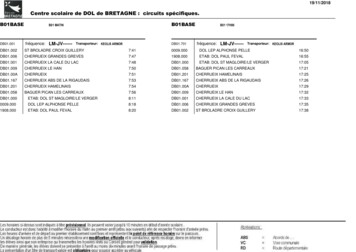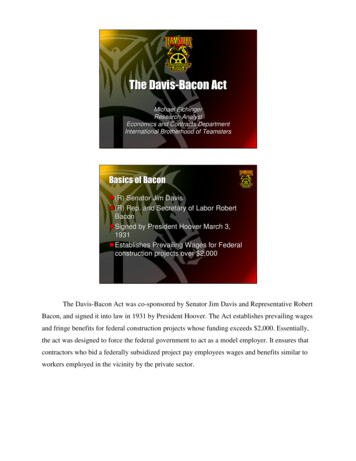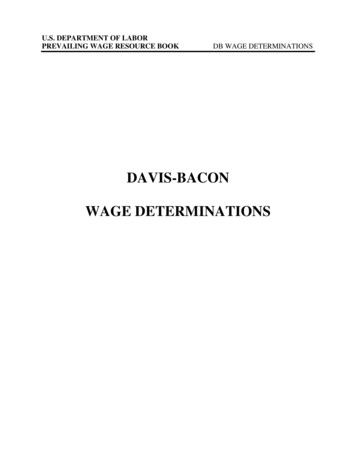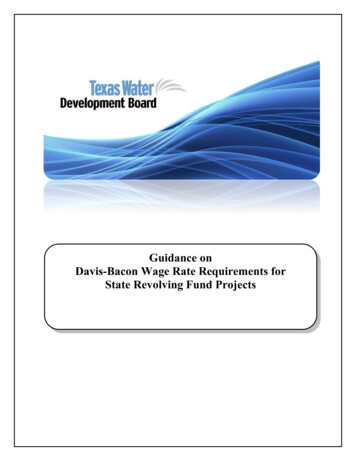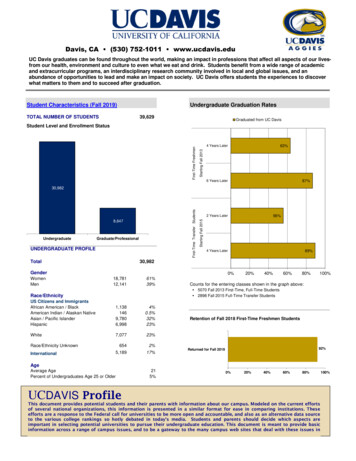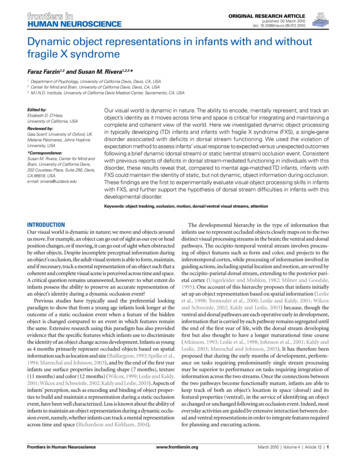
Transcription
Davis Bacon Overview
Contract Coverage
DBA Coverage Applies to contracts in excess of 2,000 towhich the Federal Government or the Districtof Columbia is a party for construction,alteration, and/or repair, including paintingand decorating, of public buildings or public works Does not apply to work performed in foreigncountries or the U.S. territories
Coverage – Contract for Construction Is the agreement a “contract for construction” towhich the Federal Government or District ofColumbia is a party? “Construction” includes all types of work done on aparticular building or work at the site thereof, asdefined in the regulations (section 5.2(j)(1)). A contract is “for construction” if “more than anincidental amount of construction‐type of activity isinvolved in the performance of the governmentcontract.”
Coverage – Public Building or Work Is the “contract for construction” a contract forconstruction of a public building or public work ofthe U.S. or the District of Columbia? A “public building” or “public work” – includes “abuilding or work, the construction, prosecution,completion, or repair of which is carried on directlyby authority of or with funds of a Federal agency toserve the interest of the general public regardlessof whether title thereof is in a Federal agency.” 29CFR 5.2(k)
SCA Maintenance vs. DBA Repair SCA Maintenance – Work is typically Scheduled, regular and recurring maintenance activities Routine to keep something in state of continuousutilization Examples: custodial service, routine HVAC filterchanges, snow removal
DBA Repair Work Typically covers activities such as restoration offacility One time fix to something not functioning Restoration, alteration or replacement of fixedcomponents Examples: building structural repair, renovation, roofshingling, paving repairs, etc.
Contracts Requiring SCA and DBA SCA and DBA both apply to contracts “principally”for services that: Contain specific requirements for substantial amountsof construction, alteration, or repair work Physically or functionally separate from other workcalled for by the contract
DBA Contract Requirements on PCAContracts If a PCA (supply) contract involves a substantialamount of construction work on a public buildingor work (exceeding the monetary threshold forDBA application), it is also subject to the DBA if theconstruction work is physically or functionallyseparate from, and is capable of being segregatedfrom, the other work required by the contract.
Leases as DBA Contracts for ConstructionAAM No. 176 AAM No. 176, issued on June 22, 1994, providesguidance on: “Application of the Davis‐Bacon Act to Buildings andWorks Constructed and/or Altered for Lease by theFederal Government.” If a lease calls for construction, alteration, and/orrepair: Apply AAM No. 176 guidance to determine whether DBArequirements need to be in the lease.
Davis Bacon Related Acts Davis‐Bacon (DB) requirements extend tonumerous “related Acts” that provide federalassistance by Grants Loans Loan guarantees Insurance
Davis Bacon Labor Standards/ContractStipulations The term “labor standards” means therequirements of: The Davis‐Bacon Act The Contract Work Hours and Safety StandardsAct The Copeland Act Prevailing wage provisions of the Davis‐Baconand “related Acts”; and Regulations, 29 C.F.R. 1, 3, and 5
Wage Determinations
Types of Wage Determination Davis‐Bacon WDs specify the prevailing wages,including fringe benefits, which are determined tobe prevailing for the described classes of laborersand mechanics employed on construction projectsof a similar character in the localities specifiedtherein Two types of wage determinations: general andproject
Selecting the Correct Category ofWage Determination Selecting and incorporating the appropriate generalwage determination for the project type BuildingResidentialHeavyHighwayGuidance provided in AAM 130 Multiple wage determinations may apply where thereare separate construction types and the different typeof construction is at least 20 percent of the project costor exceeds 2.5 million – guidance provided in AAM131 and 236.
Selecting the Correct WageDetermination ModificationIncorporate most current WD: Negotiated contracts (“RFPs”) – Time of award. Competitively bids contracts: In effect 10 days ormore before opening of bids Exceptions If the contract is not warded within 90 days of bidopening, any modification to the WD must beincorporated unless the federal agency requestsand obtains an extension to the 90 day period
Interpreting General WageDeterminationsUseful information contained in a general wagedetermination: State and county Type of construction with description Record of modifications List of classifications and rates Basis for rates – Identifiers Union Identifiers Union Weighted Average Identifiers SU Identifiers
Wage DeterminationsContracting Agency Responsibilities Ensure proper wage determination (WD) isidentified and applied Advise contractors which schedule of ratesapplies to various construction items; and Advise contractors regarding the dutiesperformed by various crafts in the WD
Conformances
Conformance Requirement Unlisted classifications needed for work not includedwithin the scope of the classifications listed may beadded after award only as provided in the laborstandards contract clauses (29CFR 5.5 (a) (1) (ii)).
Criteria for Conformance Actions The work to be performed by the proposedclassification is not performed by a classificationalready in the wage determination (WD); The proposed wage rate must bear a reasonablerelationship to WD rates; and The proposed classification is utilized in the areaby the construction industry.
“Reasonable Relationship” When determining whether a proposed rate bearsa “reasonable relationship” to wage rates in thewage determination: Determine the category of the classification in question (skilledcraft, laborer, equipment operator, or truck driver) Determine whether the majority of the rates in that category areunion or non‐union rates Consider the entirety of those rates and determine whether theproposed rate in reasonable in light of those rates Do not automatically use the lowest rate in the category
Covered Workers
Laborers and Mechanics Workers whose duties are manual or physical innature; Includes apprentices, trainees and helpers; and For CWHSSA, includes guards and watchmen. Does not include workers such as timekeepers,inspectors, architects, engineers, or bona fideexecutive, administrative, and professionalemployees as defined under FLSA Working foremen are generally non‐exempt: must be paid the Davis Bacon (DB) rate forthe classification of work performed if not541 exempt.
Apprentices Are laborers and mechanics; not listed on WDs. Only includes persons individually registered in abona fide apprenticeship program registered withDOL’s Employment Training Administration (ETA)Office of Apprenticeship (OA) or a StateApprenticeship Agency recognized by OA. Individuals in their first 90 days of probationaryemployment as an apprentice in such a program. Regulations: 29 C.F.R. §§ 5.2(n)(1) and 5.5(a)(4)(i).
Apprentice Ratios Apprentices must be employed within theallowable ratio specified in approved program forthe number of apprentices or trainees tojourneymen. “The allowable ratio of apprentices to journeymenon the job site in any craft classification shall not begreater than the ratio permitted to the contractoras to the entire work force under the registeredprogram.” 29 CFR 5.5(a)(4)(i). Compliance with the ratio is determined on a daily,not a weekly basis.
Apprentice Rates Apprentices individually registered in an approvedprogram and employed within the allowable ratiomay be paid less than the journeyworker wagewhen they are: Paid the percentage of hourly rate required by theapprenticeship or training program required foreach apprentice’s level of training; Paid the fringe benefit’s specified in approvedprogram; if the program is silent, the full amount offringe benefit’s listed on the WD
Payment of PrevailingWage Rates
Prevailing Wage Payments All laborers and mechanics employed or workingupon the site of work must be paid at least theapplicable prevailing wage rate for the classificationof work performed as listed in the applicable wagedetermination or a rate approved in accordancewith the “conformance process” set forth at 29C.F.R. § 5.5 (a)(1)(ii), without regard to skill The laborers and mechanics working on the site ofwork must be paid weekly unless the fringebenefits are paid into a bona fide FB plan and thencontributions must be paid no less often thenquarterly
Base Hourly Wage Rates andFringe Benefit Rates Under DBA, FBs are a component of the DBA“prevailing wage” The prevailing wage obligation may be satisfied by: Paying the base hourly rate (BHR) and FB in cash(including negotiable instruments payable on demand) Contributing payments to a bona fide plan; or Any combination of the two Cash wages paid in excess of BHR may count tooffset or satisfy the FB obligation (unlike underSCA); however, the regular rate for overtime cannotbe less than the BHR
Prevailing Wages for MultipleClassifications Laborers and mechanics who perform work in morethan one classification may be paid the differentapplicable rates for the work they actually performif the employer keeps an accurate record of thetime spent working in each classification and paysaccordingly. If in a single workweek an employee works in morethan one classification for which different non‐overtime rates of pay have been established, theovertime pay generally should be computed basedon the weekly average rate.
Determining Worker Classifications There are no nationwide standard classificationdefinitions under the DBA. To determine proper classifications for workersemployed on a Davis‐Bacon covered project, itmay be necessary to examine local area practice. Contracting agencies are responsible for advisingcontractors regarding the duties performed byvarious crafts in the WD
Determining Local Area Practice If, in the applicable wage determination, the rates listed forthe classification(s) that may perform the work in questionare union rates: any question will be resolved by examining thepractice(s) of union contractors in classifying workerswho have been performing the duties in question in thearea. If, in the applicable wage determination, the rates listed forthe classification(s) that may perform the work in questionare non‐union rates: any question will be resolved by examining thepractice(s) of non‐union contractors in classifyingworkers who have been performing the duties inquestion in the area.
Permissible Deductions 29 CFR 3.5 lists deductions that an employer canmake from the prevailing wage rate without theapproval of the Secretary of Labor. Examples include Social Security and federal orstate taxes, certain court‐ordered payments, bonafide pre‐payments of wages, certain payments ofunion dues, and voluntary charitable donations.
Deductions Requiring Approval 29 CFR 3.6 generally provides that the Secretarymay approve other deductions whenever all of thefollowing conditions are met: The contractor does not profit directly or indirectly from thededuction The deduction is not otherwise prohibited by law Either the employee voluntarily consented to the deduction inwriting in advance of the time that the work was performed or thededuction is under the terms of a collective bargaining agreement The deduction serves the convenience and interest of the employee Requests for approval must be made annually inwriting, as described at 29 CFR 3.7, and may besent to dbadeductions@dol.gov.
Fringe Benefits
Funded Fringe Benefit Plans Contractors may take credit (without prior approvalfrom DOL) for bona fide FB fund contributionsmade to third‐party trustees or insurers that: Are irrevocably paid; and Are made regularly, not less often than quarterly Credit is for payments made for individual workerseligible to participate in the plan, program, or fund.
Unfunded Fringe Benefit Plans Costs for an “unfunded” FB plan count towards WDobligation if specific criteria are met: The contributions reasonably anticipate the cost toprovide a bona fide FB Contributions are made pursuant to an enforceablecommitment That is carried out under a financially responsible plan;and The plan has been communicated in writing to affectedworkers Contractors must submit a written request for DOLapproval of unfunded plans, as required by 29 CFR5.5(a)(1)(iv), prior to claiming fringe benefit credit.
Eligibility and Participation Employers may not take credit for contributions foremployees who are not eligible to participate in thefringe benefit plan. Employers may take credit for contributions madeon behalf of employees who will likely becomeparticipants in a plan but are not yet eligible toreceive benefits (for example, a health insuranceplan with a 30 day waiting period for newparticipants)
Administrative Expenses The administrative expenses incurred by acontractor or subcontractor in connection with theadministration of a bona fide fringe benefit plan arenot creditable towards the prevailing wage underthe DBA.
Annualization Principle Davis‐Bacon credit is based on the effective annualrate of contributions for all hours worked in a year(both Davis‐Bacon and non‐Davis‐Bacon work). Davis‐Bacon work may not be used as the exclusive ordisproportionate source of funding for a benefit in effectduring both covered and non‐covered work. Determine the hourly rate of contribution that iscreditable towards a contractor’s Davis‐Baconprevailing wage obligation by dividing the totalannual contributions by the total annual hoursworked (both Davis‐Bacon and non‐Davis‐Baconwork).
Recordkeeping andCertified Payrolls
Payroll and Basic Records Payrolls and related basic records shall be maintained by thecontractor during the course of the work and for three yearsthereafter for all laborers and mechanics working at the siteof the work. Such records shall contain the name, address, and socialsecurity number of each such worker, his or her correctclassification, hourly rates of wages paid (including rates ofcontributions or costs anticipated for bona fide fringebenefits or cash equivalents thereof of the types describedin section 1(b)(2)(B) of the Davis‐Bacon Act), daily andweekly number of hours worked, deductions made andactual wages paid. 29 CFR 5.5(a)(3)(i)
Certified Payroll Clauses Two separate contract clause requirements apply to“certified payrolls” for a project: The contractor shall submit weekly for any week inwhich any contract work is performed a copy of allpayrolls, which must contain the information that thecontractor is required to maintain under § 5.5(a)(3)(i).29 C.F.R. § 5.5 (a)(3)(ii)(A) Each weekly payroll submitted must be accompanied bya “Statement of Compliance”. 29 C.F.R. § 5.5 (a)(3)(ii)(B)
“Statement of Compliance” Must be executed by the contractor orsubcontractor or by an authorized officer oremployee of the contractor or subcontractor whosupervises the payment of wages. 29 C.F.R. §3.3(b). Each weekly statement must be delivered ormailed by the contractor or subcontractor, withinseven days after the regular payment date of thepayroll period, to a representative of a Federal orState agency contracting for or financing thebuilding or work. 29 C.F.R. § 3.4(a).
Certified Payrolls &Signatures The signature on each weekly “Statement ofCompliance” may be either an originalhandwritten or an electronic signature. A contracting agency or prime contractor maypermit or require contractors to submit theweekly payrolls, each with the accompanying”Statement of Compliance” through anelectronic system.
Falsification of Certified Payrolls The importance of the “Statement ofCompliance” requirement is clear in that: “The falsification of any of the above certificationsmay subject the contractor or subcontractor tocivil or criminal prosecution under section 1001 oftitle 18 and section 231 of title 31 of the UnitedStates Code.”29 C.F.R. § 5.5(a)(3)(ii)(D),reiterated at FAR 48 C.F.R. § 52.222‐8(b)(4).
Investigations andRemedies
Investigations DOL Functions/Responsibilities: Determining “prevailing wages” Issuing regulations and standards to be observed by contractingagencies; and Perform oversight function and has independent authority toconduct investigations In addition to including the contract stipulationsand correct wage determinations, contractingagencies also have the authority to conductinvestigations
Investigative Process Initial conference with contractorExamine certified payrollsExamine basic payroll recordsCheck for compliance with apprenticeship and/ortrainee requirementsInterview employeesDetermine if a conformance is necessaryCompute back wages and liquidated damages, if anyFinal conference to discuss results of the investigation
Employee Interviews Are essential to the investigation. Information provided is confidential. Interview statements should contain: Place and date of interview; Name and address of employer/employee; Information about employment status andclassification; and Alleged violations.
Withholding DBA and CWHSSA provide for withholding ofcontract funds to satisfy alleged wageunderpayments pending resolution of a wagedispute 40 U.S.C. § 3142 (c)(3); 40 U.S.C. § 3702 (d) Withholding of contract funds is an effectiveenforcement tool in DBA/DBRA/CWHSSA cases It protects the rights of covered workers to wages duethem
Withholding of Contract FundsFAR (48 C.F.R. Part 22) FAR guidance in 48 C.F.R. Part 22 instructs that if thecontracting officer believes a violation exists, or uponrequest of the Department of Labor: the contracting officer must withhold from paymentsdue the contractor an amount equal to the estimatedwage underpayment and estimated liquidated damagesdue under the CWHSSA. 48 C.F.R. § 22.406‐9 (a)
Withholding of Contract FundsFAR (48 C.F.R. Part 22, cont’d.) If subsequent investigation confirms violations, thecontracting officer must adjust the withholding asnecessary If DOL requested the withholding, the contractingofficer must not reduce or release the withheldfunds without written approval by DOL The withheld funds are to be used to satisfy: assessed liquidated damages; and unless the contractor makes restitution, validated wageunderpayments
Debarment Occurs when a contractor is declared ineligible forfuture contracts due to: Violations of the DBA in disregard of its obligations toemployees or subcontractors Aggravated or willful violations under the laborstandards provisions of the related Acts Period of ineligibility is 3 years for DBA and up to 3years for DBRA The debarment process is provided at 29 C.F.R. §5.12 (b)
Debarment Criteria Debarment is considered when a contractor has: Submitted falsified certified payrollsRequired “kickbacks” of wages or back wagesCommitted repeat violationsCommitted serious violationsMisclassified covered workers in clear disregard ofproper classification norms; and/or As a prime contractor, failed to ensure compliance bysubcontractors
AAM Guidance – Referral to WHD Refusal‐to‐Pay & Debarment Cases AAM No. 215, dated March 7, 2014 providescontracting agencies with guidanceregarding: Referral of refusal‐to‐pay and debarment casesto the WHD regional offices; and Procedures for contracting agencies to use whensending withheld funds due covered laborersand mechanics to WHD for disbursement
Internet Sites Wage Determinations – https://sam.gov Wage and Hour Division ntracts Resource Book ontracts/prevailing‐wage‐resource‐book Office of the Administrative Law Judges Law Library ‐http://www.oalj.dol.gov Administrative Review Board ‐ http://www.dol.gov/arb
Disclaimer This presentation is intended as general information onlyand does not carry the force of legal opinion The Department of Labor is providing this information as apublic service. This information and related materials arepresented to give the public access to information onDepartment of Labor programs. You should be aware that,while we try to keep the information timely and accurate,there will often be a delay between official publications ofthe materials and the modification of these pages.Therefore, we make no express or implied guarantees. TheFederal Register and the Code of Federal Regulationsremain the official source for regulatory informationpublished by the Department of Labor. We will make everyeffort to keep this information current and to correcterrors brought to our attention
"Application of the Davis‐Bacon Act to Buildings and Works Constructed and/or Altered for Lease by the Federal Government." If a lease calls for construction, alteration, and/or repair: Apply AAM No. 176 guidance to determine whether DBA requirements need to be in the lease.
